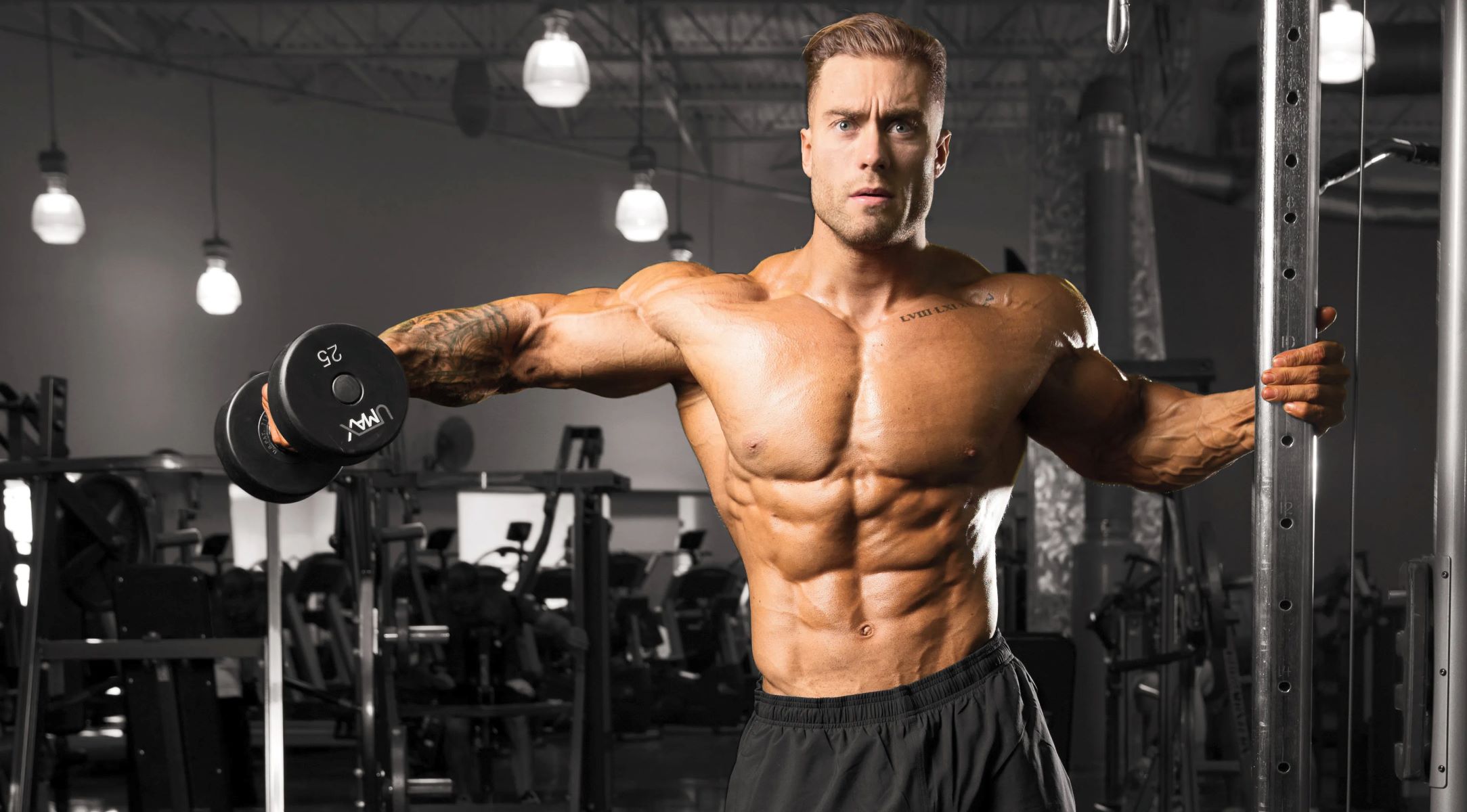Home>Health and Wellness>Top 5 Shoulder Workouts For Massive Gains!


Health and Wellness
Top 5 Shoulder Workouts For Massive Gains!
Published: February 5, 2024
Enhance your health and wellness with our top 5 shoulder workouts for massive gains. Achieve strength and definition with these effective exercises.
(Many of the links in this article redirect to a specific reviewed product. Your purchase of these products through affiliate links helps to generate commission for Regretless.com, at no extra cost. Learn more)
Table of Contents
Introduction
When it comes to sculpting a well-defined upper body, focusing on shoulder workouts is essential for achieving a balanced and strong physique. The shoulders, being one of the most mobile and versatile joints in the body, play a pivotal role in supporting various upper body movements and maintaining overall stability. Whether you're a fitness enthusiast aiming to build impressive deltoid muscles or someone seeking to enhance functional strength, incorporating targeted shoulder exercises into your workout routine can yield significant benefits.
A robust shoulder workout regimen not only contributes to aesthetic gains but also enhances shoulder stability and functionality, reducing the risk of injuries and improving overall posture. By engaging in a diverse range of shoulder exercises, individuals can effectively target the anterior, lateral, and posterior deltoid heads, thereby ensuring comprehensive development and strength across all regions of the shoulders.
In this article, we will explore the top five shoulder workouts that are renowned for their efficacy in promoting massive gains and overall shoulder development. From classic overhead presses to dynamic lateral raises, each exercise offers unique benefits and contributes to a well-rounded shoulder training routine. By understanding the mechanics and advantages of these exercises, you can tailor your workouts to maximize gains and achieve a well-defined, powerful upper body.
By incorporating these shoulder workouts into your fitness regimen, you can embark on a journey toward achieving impressive shoulder strength, stability, and aesthetics. Whether you're a seasoned fitness enthusiast or just beginning your fitness journey, the following exercises are versatile and adaptable to various fitness levels, making them valuable additions to any workout routine. Let's dive into the details of each exercise and discover how they can contribute to your quest for massive shoulder gains and overall upper body strength.
Overhead Press
The overhead press, also known as the military press, stands as a fundamental and highly effective shoulder exercise that targets the entire deltoid complex, as well as the triceps and upper chest. This compound movement involves pressing a barbell or dumbbells overhead from a standing position, thereby engaging multiple muscle groups to execute the lift.
To perform the overhead press, begin by standing with feet shoulder-width apart and grasping the barbell or dumbbells with an overhand grip, positioning them at shoulder level. With a straight back and engaged core, press the weight overhead in a vertical motion until the arms are fully extended. Lower the weight back to the starting position with controlled movement, ensuring proper form and alignment throughout the exercise.
The overhead press is renowned for its ability to promote significant shoulder strength and muscle development. By engaging the deltoids, triceps, and upper chest, this exercise not only contributes to aesthetic gains but also enhances functional upper body strength and stability. Additionally, the overhead press stimulates core activation, promoting overall body stability and control during the movement.
One of the notable advantages of the overhead press is its versatility, as it can be performed with various equipment, including barbells, dumbbells, kettlebells, or even resistance bands. This adaptability allows individuals to customize their workouts based on equipment availability and personal preferences, making the overhead press accessible to a wide range of fitness enthusiasts.
Furthermore, the overhead press offers progressive overload potential, enabling individuals to continually challenge their shoulder muscles by increasing the weight lifted over time. This progressive approach is instrumental in stimulating muscle growth and strength development, making the overhead press a cornerstone exercise for those aiming to achieve massive shoulder gains.
Incorporating the overhead press into a comprehensive shoulder workout routine can yield substantial benefits, including enhanced shoulder stability, improved posture, and increased upper body strength. Whether performed as a standalone exercise or as part of a structured strength training program, the overhead press remains a staple in shoulder workouts, offering a reliable and effective means of targeting the deltoids and supporting muscle groups.
By integrating the overhead press into your fitness regimen, you can harness its potential to sculpt well-defined shoulders, build upper body strength, and elevate overall physical performance. This classic exercise, with its emphasis on shoulder development and functional strength, exemplifies the timeless effectiveness of fundamental movements in achieving massive gains and holistic fitness.
Dumbbell Shoulder Press
The dumbbell shoulder press, a prominent compound exercise, is revered for its ability to target the deltoid muscles while engaging the stabilizing muscles of the core and upper body. This versatile movement can be performed in either a seated or standing position, offering flexibility and adaptability to suit individual preferences and fitness levels.
To execute the dumbbell shoulder press, begin by sitting on a bench with back support or standing with feet shoulder-width apart, holding a pair of dumbbells at shoulder height. With a firm grip and engaged core, press the dumbbells overhead in a controlled motion until the arms are fully extended. Lower the weights back to the starting position with deliberate movement, maintaining proper form and alignment throughout the exercise.
The dumbbell shoulder press is renowned for its capacity to promote balanced shoulder development and strength, targeting the anterior, lateral, and posterior deltoid heads. By engaging these key muscle groups, individuals can effectively enhance shoulder stability and functionality, contributing to improved posture and reduced risk of injury during daily activities and workouts.
One of the notable advantages of the dumbbell shoulder press lies in its ability to offer unilateral training benefits, allowing each shoulder to work independently. This feature is particularly beneficial for addressing muscle imbalances and promoting symmetrical shoulder development, ultimately supporting overall shoulder health and performance.
Furthermore, the dumbbell shoulder press facilitates a wide range of motion, enabling individuals to customize the exercise based on their shoulder mobility and comfort levels. This adaptability makes the exercise accessible to a diverse demographic, including individuals with varying fitness backgrounds and shoulder strength.
Incorporating the dumbbell shoulder press into a comprehensive shoulder workout routine can yield significant gains in shoulder strength, stability, and aesthetics. Whether integrated as a standalone exercise or as part of a structured strength training program, the dumbbell shoulder press serves as a valuable tool for sculpting well-defined shoulders and enhancing overall upper body strength.
By embracing the dumbbell shoulder press as a foundational component of a holistic fitness regimen, individuals can harness its potential to foster impressive shoulder gains, promote functional strength, and elevate their overall physical performance. This dynamic exercise exemplifies the efficacy of targeted shoulder workouts in achieving comprehensive shoulder development and supporting a strong, resilient upper body.
Arnold Press
The Arnold press, named after the legendary bodybuilder Arnold Schwarzenegger, is a dynamic shoulder exercise renowned for its unique movement pattern and comprehensive targeting of the deltoid muscles. This exercise involves a rotational component that engages the shoulders through a full range of motion, contributing to balanced muscle development and functional strength.
To perform the Arnold press, begin by sitting on a bench with back support or standing with feet shoulder-width apart, holding a pair of dumbbells at shoulder height with palms facing towards the body. Initiate the movement by pressing the dumbbells overhead while simultaneously rotating the wrists, so that the palms face forward at the top of the motion. Lower the dumbbells back to the starting position while reversing the wrist rotation, maintaining control and alignment throughout the exercise.
The distinctive rotational element of the Arnold press sets it apart from traditional shoulder exercises, as it targets the deltoid muscles from multiple angles, emphasizing both the anterior and lateral heads. This comprehensive engagement of the deltoids contributes to well-rounded shoulder development and enhances shoulder stability, promoting improved posture and functional movement patterns.
One of the notable advantages of the Arnold press is its capacity to challenge the shoulders through a diverse range of motion, fostering shoulder flexibility and mobility. The rotational aspect of the exercise encourages dynamic shoulder activation, promoting joint health and resilience while supporting overall upper body functionality.
Furthermore, the Arnold press offers a versatile training stimulus, allowing individuals to customize the exercise based on their shoulder strength and mobility. By adjusting the weight and range of motion, individuals can tailor the Arnold press to suit their fitness levels and training objectives, making it accessible to a broad spectrum of fitness enthusiasts.
Incorporating the Arnold press into a comprehensive shoulder workout routine can yield significant benefits, including enhanced shoulder stability, improved functional strength, and aesthetic development. Whether integrated as a standalone exercise or as part of a structured strength training program, the Arnold press stands as a valuable tool for sculpting well-defined shoulders and promoting balanced muscle engagement.
By embracing the Arnold press as a foundational component of a holistic fitness regimen, individuals can harness its potential to foster impressive shoulder gains, promote dynamic strength, and elevate their overall physical performance. This dynamic exercise exemplifies the efficacy of targeted shoulder workouts in achieving comprehensive shoulder development and supporting a strong, resilient upper body.
Lateral Raises
Lateral raises are a quintessential shoulder exercise that specifically targets the medial or lateral head of the deltoid muscles. This fundamental movement involves lifting weights away from the body in a lateral motion, effectively engaging the shoulders to promote muscle development and strength. Lateral raises can be performed using dumbbells, resistance bands, or cable machines, offering versatility and adaptability to suit individual preferences and fitness levels.
To execute lateral raises, begin by standing with feet shoulder-width apart, holding a pair of dumbbells at your sides with palms facing inward. With a slight bend in the elbows and engaged core, raise the dumbbells laterally until they reach shoulder height, maintaining controlled movement throughout the exercise. Slowly lower the weights back to the starting position, ensuring deliberate and controlled motion to optimize muscle engagement.
One of the key advantages of lateral raises lies in its ability to isolate the lateral head of the deltoids, contributing to balanced shoulder development and enhanced shoulder width. By targeting this specific muscle group, individuals can effectively enhance shoulder aesthetics and create a well-defined, sculpted appearance. Additionally, lateral raises play a crucial role in strengthening the shoulders, supporting overall upper body stability and functionality.
Moreover, lateral raises facilitate a wide range of motion, allowing individuals to customize the exercise based on their shoulder strength and comfort levels. This adaptability makes the exercise accessible to individuals with varying fitness backgrounds and shoulder strength, enabling them to tailor their workouts to suit their specific needs and goals.
Incorporating lateral raises into a comprehensive shoulder workout routine can yield significant benefits, including enhanced shoulder aesthetics, improved muscle definition, and increased shoulder strength. Whether integrated as a standalone exercise or as part of a structured strength training program, lateral raises serve as a valuable tool for sculpting well-defined shoulders and promoting balanced muscle engagement.
By embracing lateral raises as a foundational component of a holistic fitness regimen, individuals can harness its potential to foster impressive shoulder gains, promote aesthetic development, and elevate their overall physical performance. This dynamic exercise exemplifies the efficacy of targeted shoulder workouts in achieving comprehensive shoulder development and supporting a strong, resilient upper body.
Read more: Top 5 Heartwarming Anime For Romance Lovers!
Face Pulls
Face pulls are a dynamic and effective exercise that targets the rear deltoids, upper back, and rotator cuff muscles, playing a crucial role in promoting balanced shoulder development and overall upper body strength. This versatile movement, often performed using a cable machine with a rope attachment, offers a unique approach to enhancing shoulder stability, posture, and functional strength.
To execute face pulls, begin by setting the cable machine at an appropriate height and attaching a rope handle. Stand facing the cable machine, grasp the rope handles with an overhand grip, and take a few steps back to create tension in the cable. With a slight bend in the elbows and engaged core, pull the rope towards your face, leading with the elbows and squeezing the shoulder blades together at the peak of the movement. Slowly return the rope to the starting position with controlled movement, maintaining proper form and alignment throughout the exercise.
One of the key advantages of face pulls lies in its ability to target the often-neglected rear deltoids and upper back muscles, addressing muscle imbalances and promoting comprehensive shoulder development. By engaging these specific muscle groups, face pulls contribute to improved shoulder stability and posture, ultimately reducing the risk of injury and enhancing overall upper body functionality.
Furthermore, face pulls facilitate scapular retraction, promoting healthy shoulder mechanics and supporting optimal shoulder joint movement. This aspect of the exercise is instrumental in addressing postural issues and reinforcing shoulder stability, which is particularly beneficial for individuals who spend extended periods in sedentary positions, such as sitting at a desk or using electronic devices.
Additionally, face pulls offer a versatile training stimulus, allowing individuals to customize the exercise based on their shoulder strength and mobility. By adjusting the weight and handle position, individuals can tailor face pulls to suit their fitness levels and training objectives, making it accessible to a broad spectrum of fitness enthusiasts.
Incorporating face pulls into a comprehensive shoulder workout routine can yield significant benefits, including enhanced shoulder stability, improved posture, and reduced risk of shoulder injuries. Whether integrated as a standalone exercise or as part of a structured strength training program, face pulls serve as a valuable tool for sculpting well-defined shoulders and promoting balanced muscle engagement.
By embracing face pulls as a foundational component of a holistic fitness regimen, individuals can harness its potential to foster impressive shoulder gains, promote functional strength, and elevate their overall physical performance. This dynamic exercise exemplifies the efficacy of targeted shoulder workouts in achieving comprehensive shoulder development and supporting a strong, resilient upper body.














